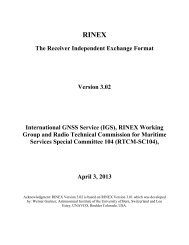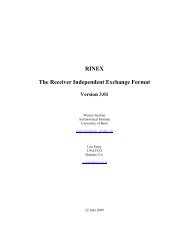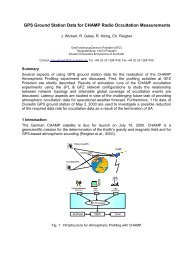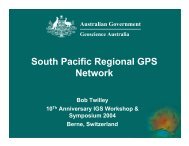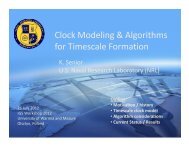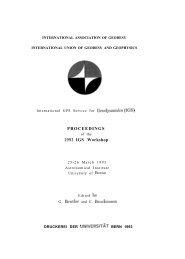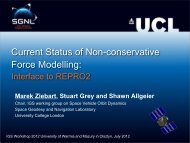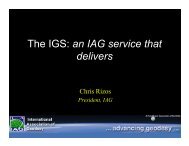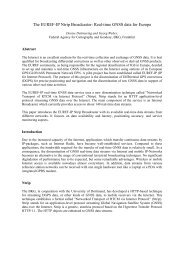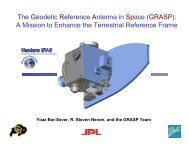IGS Analysis Center Workshop - IGS - NASA
IGS Analysis Center Workshop - IGS - NASA
IGS Analysis Center Workshop - IGS - NASA
You also want an ePaper? Increase the reach of your titles
YUMPU automatically turns print PDFs into web optimized ePapers that Google loves.
SUMMARY OF SESSION 2The second session concentrated on orbit combination and consisted of two presentations followedby a discussion. In the first presentation, entitled ‘What can be learned from other satellites’, Prof.Bob Schutz outlined the extensive experience with precise orbit determination at the <strong>Center</strong> forSpace Research (CSR) of the University of Texas. The long arc precise orbit determinations (up toseveral years) for the LAGEOS and ETALON satellites were discussed. The ETALON satellitesare particularly interesting as they have similar orbits to GPS. For both ETALON satellites, CSRwas able to determine long arcs (600-800days) with some empirical orbit corrections every 30daywith postfit range residuals of about 6cm. A possible problem identified and applicable to GPS isthe error contribution of Earth gravity models due to the deep resonance of the GPS orbits. TheGPS measurements on TOPEX/ POSEIDON as well as to a GLONASS laser reflector on PRN5will improve GPS error modelling. CSR was able to fit external GPS orbits (from CODE and GFZ)to about 3cm RMS. In the second presentation Prof. G. Beutler presented the Position Paper II (seeabove) on some possible approaches to orbit combination. Two methods for combining orbits wereproposed, the first one based on a refined weighted average and the second on orbit dynamics. Thepresentation was followed by extensive discussions on the subject.The most controversial and lively discussions were on specific submission deadlines for orbitsolutions. Finally, a two week (maximum) deadline was agreed upon at least for the initial stages,with the understanding that <strong>Center</strong>s will make an effort to submit their results as soon as they areavailable (daily or several times a week), hopefully well before this deadline. In any case, themaximum wait period will be two weeks from the date of data collection or until all <strong>Center</strong> resultsare submitted, whichever comes first. Another ‘intensive’ discussion related to benefits of fixingversus constraining some ITRF coordinates. It was felt that by not fixing the known ITRFcoordinates the reference frame could be compromised (drifting orientation). However, it waspointed out that <strong>Center</strong>s which do not fix coordinates in fact show better frame stability than most<strong>Center</strong>s. By constraining the station coordinates, it is hoped that small unmodelled stationmovements and errors in the ITRF coordinates are mitigated. At the end it was agreed that bothfixing and/or sufficient constraining are acceptable and consistent with IERS/<strong>IGS</strong> standards.To reflect the nature of operation of both <strong>IGS</strong> and IERS two combined orbit products wereproposed, the first ‘Rapid orbit products’ to be based on IERS Rapid service (Bull. A) and to beavailable as soon as all orbits are submitted or within two weeks. The second, ‘Final orbit product’should be consistent with the final IERS EOP (Bull. B) and should be made available within a fewmonths. This final <strong>IGS</strong> orbit could be potentially more accurate than the rapid orbit, e.g. due tousing more accurate EOP or by including the late or resubmitted (corrected) orbits. In addition tocreating both <strong>IGS</strong> products as above, the continuation of archiving and distribution of individual<strong>Center</strong> products was supported by all participants. As shown in the position paper some regionalorbits may be approaching the precision of combined orbits for certain regions and also they willlikely be available before the <strong>IGS</strong> orbit products are generated.The relative advantages and disadvantages of both orbit combination methods proposed in theposition paper were discussed. At the end the general feeling was that, at least for the time being,the weighted average method, based on the L1 norm should be adopted for the <strong>IGS</strong> orbitcombination and the second approach based on orbital dynamics should be used for long arc orbitvalidation only. The L 1 norm estimation appears to be less sensitive to outlier orbits and thus saferfor operational purposes. Besides it can also accommodate some unconventional orbitdeterminations (e.g. based on stochastic modeling for some orbit parameters). During the57




